
Call us out for foundation repair in Allegheny, Butler, and Washington Counties
It goes without saying that your foundation is vital to the stability of your house. If your foundation is compromised, so too is your home. A Plus Concrete & Foundation Repair provides foundation repair services using the Three-Point Carbon-Fiber and Kevlar System by Fortress Stabilization that stops foundation movement in its tracks. Whether your concrete block foundation is bowing, tipping, or sheering, the three-point systems guarantees that your foundation wall will not move again for a life-time and that is backed up by a true life-time transferable warranty.
Don’t wait. Once a foundation has shifted too much, it will no longer qualify for repair and may require being completely rebuilt. Call us today to talk over your project and schedule a free estimate for Foundation Restoration Services.
ADVANTAGES:
The Fortress top anchor is post-tensioned after installation.
This ensures that the top anchor and wall are engaged under tension, and holding fast, when the job is complete. No other company has a post-tensioned wall anchor.
Bolting to the rim joist is safer. The sill plate is not adequately connected to the floor joist to carry the load.
The Fortress top anchor is mechanically fastened to the rim joist, not the sill plate. By connecting to the rim joist, the Fortress top anchor engages the building’s floor system, providing a stronger, more durable anchor. This prevents any movement of the basement wall.
A stronger connection.
Many older homes do not have enough sill plate-to-foundation wall connections to ensure that the sill plate will hold under stress. Engaging the floor system (first story floor to top of basement wall) provides the strongest, safest connection.
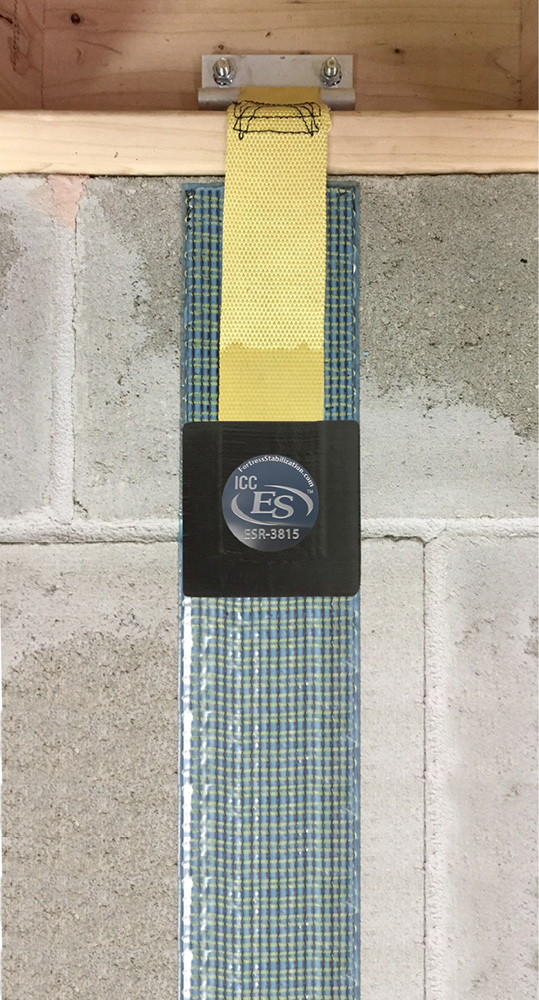
ADVANTAGES:
The quality of the bottom anchor construction is very important.
Because preventing shear requires strength, we made our bottom anchor over 5 times thicker and 125 times stiffer than the competition. In addition, we make sure that the connection to the foundation is absolutely secure. We use a dual leg solution with specific contact lengths engineered to achieve a 200% safety factor. Our bottom plate anchor is the best in the industry.
The Fortress bottom anchor secures your wall from shear slide.
Shear slides can occur at the bottom of masonry walls where shear forces are greatest. This inward movement of the wall is defined as shear. In typical situations the basement floor holds the bottom of your wall from moving in, but where there are excessive shear forces, the Fortress bottom anchor is needed. The bottom anchor uses the basement floor to secure the Carbon-Kevlar strap and prevents shear slides. The bottom anchor is used in both block and poured concrete walls.
The best solution for bottom-of-wall anchors.
The Fortress bottom anchor takes the proven American Concrete Institute recommendation for anchoring carbon fiber straps and makes it better.
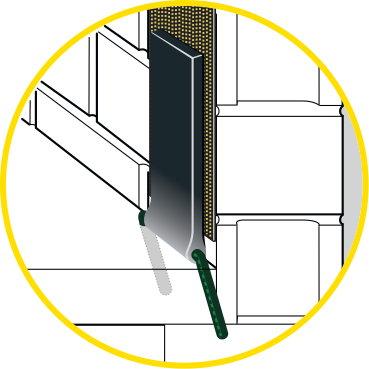
ADVANTAGES:
Not all carbon fiber is created equal.
Before considering another carbon fiber system, ask how their fibers are arranged. Conventional manufactures commonly weave the carbon. This produces an attractive woven pattern, but this method also crimps the fibers while going over and under each other. When force is applied to a woven pattern, the bent fibers try to straighten out, which reduces effectiveness.
You can see that it’s done right.
Fortress has always been concerned with having the best composite performance. All strength in fiber composites is gained when the fibers are straight. Unidirectional fibers lay flat, eliminating flex when force is applied. The unidirectional method Fortress has developed creates a product twice as strong as products using woven carbon fibers. This Fortress propriety manufacturing process allows for a true unidirectional carbon product, which is the perfect tool to reinforce foundations.
Exclusive open grid technology.
The Fortress open grid technology (OGT) combined with epoxy rivet technology (ERT) connects to the carbon grid to form a mechanical bond to the wall. Epoxy rivet technology forms an adhesive bond between the grid and the masonry substrate which load to the carbon fiber, creating an adhesive bond as well as a mechanical “rivet” between each fiber of the grid. There are over 8,000 epoxy rivets securing a single strap to your wall. OGT and ERT are exclusive to the Fortress system.

 April 2022. Here is the existing bowing wall.
April 2022. Here is the existing bowing wall.
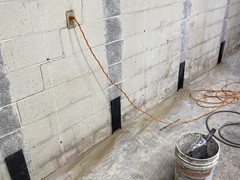 April 2022. The wall was grinded down, and the bottom anchors were installed.
April 2022. The wall was grinded down, and the bottom anchors were installed.
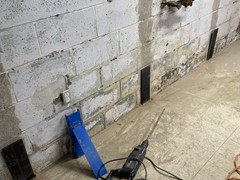 ) April 2022. Here is another view of the installed bottom anchors.
) April 2022. Here is another view of the installed bottom anchors.
 April 2022. The Top Neckties are now being installed.
April 2022. The Top Neckties are now being installed.
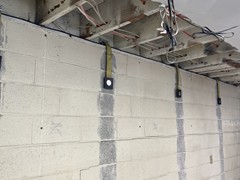 April 2022. Another view of the installed Top Neckties.
April 2022. Another view of the installed Top Neckties.
 April 2022. The Carbon Kevlar Fiber stabilizing straps are being installed.
April 2022. The Carbon Kevlar Fiber stabilizing straps are being installed.
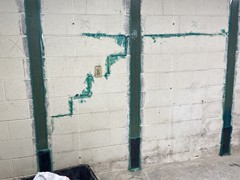 April 2022. This is another view of the installed straps. The cracks were filled in with epoxy (green colored lines).
April 2022. This is another view of the installed straps. The cracks were filled in with epoxy (green colored lines).
 April 2022. This is the final view of the completed three-point system, which is also I.C.C. Certified.
April 2022. This is the final view of the completed three-point system, which is also I.C.C. Certified.
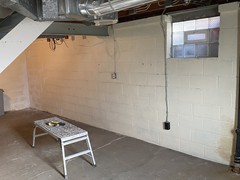 March 2022. This is a photo of a bowing basement wall.
March 2022. This is a photo of a bowing basement wall.
 March 2022. Here is another view of the bowing wall.
March 2022. Here is another view of the bowing wall.
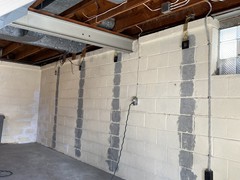 March 2022. The wall was grinded down to the raw cinder block, so that it’s ready to accept the stabilizing straps.
March 2022. The wall was grinded down to the raw cinder block, so that it’s ready to accept the stabilizing straps.
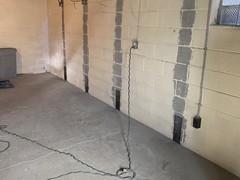 March 2022. The neckties (top anchors) and sheer plates (bottom anchors) have been installed.
March 2022. The neckties (top anchors) and sheer plates (bottom anchors) have been installed.
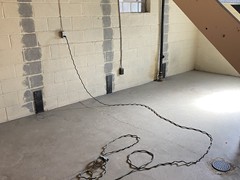 March 2022. Another view of the neckties and sheer plates.
March 2022. Another view of the neckties and sheer plates.
 March 2022. The carbon Kevlar fiber straps were installed and the job is complete. The Fortress Invisibeam system is ICC-ES Certified.
March 2022. The carbon Kevlar fiber straps were installed and the job is complete. The Fortress Invisibeam system is ICC-ES Certified.
 March 2022. This is another view of the completed installation. Fortress Stabilization provides a Lifetime Warranty on this work, and it’s transferable to a new owner.
March 2022. This is another view of the completed installation. Fortress Stabilization provides a Lifetime Warranty on this work, and it’s transferable to a new owner.
 This customer had two (2) bowing walls in the basement. They both were bowing approximately two (2) inches. This is a photo of the first bowing wall.
This customer had two (2) bowing walls in the basement. They both were bowing approximately two (2) inches. This is a photo of the first bowing wall.
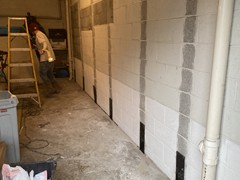 Our crew grinded the wall where the stabilizing straps will be located. The bottom anchors were installed.
Our crew grinded the wall where the stabilizing straps will be located. The bottom anchors were installed.
 The carbon fiber-kevlar straps are installed, along with the top anchors. The work on this wall is completed.
The carbon fiber-kevlar straps are installed, along with the top anchors. The work on this wall is completed.
 This is the second basement wall that is bowing.
This is the second basement wall that is bowing.
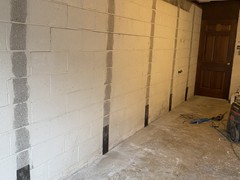 The wall was grinded where the straps will be installed, and the bottom anchors are installed.
The wall was grinded where the straps will be installed, and the bottom anchors are installed.
 The top anchors are installed.
The top anchors are installed.
 The straps are installed. In addition, all of the existing cracks in this wall were sealed with epoxy. The job is complete and there is a LIFETIME warranty on the stabilization!
The straps are installed. In addition, all of the existing cracks in this wall were sealed with epoxy. The job is complete and there is a LIFETIME warranty on the stabilization!
 Bowing wall - this garage wall was behind a peg board. The peg board was removed to expose the bowing wall.
Bowing wall - this garage wall was behind a peg board. The peg board was removed to expose the bowing wall.
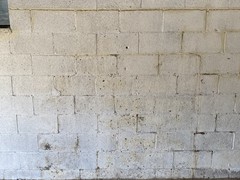 Bowing wall - this is another portion of the garage wall that is also bowing.
Bowing wall - this is another portion of the garage wall that is also bowing.
 Bowing wall - we use the Fortress Stabilization System on walls like this to stop further movement. This wall was grinded down in order to accept the straps. The bottom anchors were installed.
Bowing wall - we use the Fortress Stabilization System on walls like this to stop further movement. This wall was grinded down in order to accept the straps. The bottom anchors were installed.
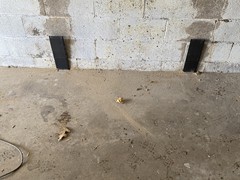 Bowing wall - this is another view of the garage wall that was grinded down to accept the straps. The bottom anchors were installed.
Bowing wall - this is another view of the garage wall that was grinded down to accept the straps. The bottom anchors were installed.
 Bowing wall - the Fortress Carbon Fiber-Kevlar straps were installed, along with the bottom anchors.
Bowing wall - the Fortress Carbon Fiber-Kevlar straps were installed, along with the bottom anchors.
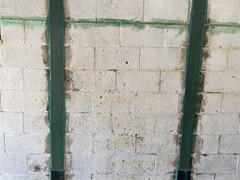 Bowing wall - in addition to the Carbon Fiber-Kevlar straps, the horizontal crack (green) in the wall was filled with epoxy.
Bowing wall - in addition to the Carbon Fiber-Kevlar straps, the horizontal crack (green) in the wall was filled with epoxy.
 Bowing wall - the Fortress Stabilization System composed of Carbon Fiber-Kevlar straps, with accompanying top and bottom anchors were installed at four (4) foot intervals on the wall to stabilize it from further movement.
Bowing wall - the Fortress Stabilization System composed of Carbon Fiber-Kevlar straps, with accompanying top and bottom anchors were installed at four (4) foot intervals on the wall to stabilize it from further movement.
 Crack repair – you can clearly see a large vertical crack in this basement floor.
Crack repair – you can clearly see a large vertical crack in this basement floor.
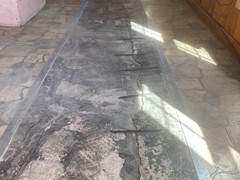 Crack repair – this is the beginning of the process to install carbon fiber stitches along the crack that will stabilize it and stop any further movement.
Crack repair – this is the beginning of the process to install carbon fiber stitches along the crack that will stabilize it and stop any further movement.
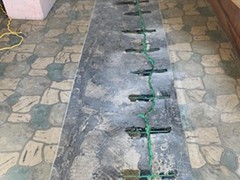 Crack repair – these are the installed carbon fiber stitches.
Crack repair – these are the installed carbon fiber stitches.
 Crack repair – polymer cement has been applied over the entire area for a smooth surface.
Crack repair – polymer cement has been applied over the entire area for a smooth surface.
 Fortress Stabilization System showing installed top anchors. Top anchors are post-tensioned after installation to ensure that the top anchor and wall are engaged under tension, and holding fast, when the job is complete. No other company has a post-tensioned wall anchor.
Fortress Stabilization System showing installed top anchors. Top anchors are post-tensioned after installation to ensure that the top anchor and wall are engaged under tension, and holding fast, when the job is complete. No other company has a post-tensioned wall anchor.
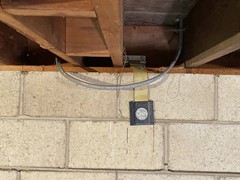 Fortress Stabilization System showing installed top anchors. Top anchors are post-tensioned after installation to ensure that the top anchor and wall are engaged under tension, and holding fast, when the job is complete. No other company has a post-tensioned wall anchor.
Fortress Stabilization System showing installed top anchors. Top anchors are post-tensioned after installation to ensure that the top anchor and wall are engaged under tension, and holding fast, when the job is complete. No other company has a post-tensioned wall anchor.
 Fortress Stabilization System Carbon-Kevlar straps installed. How the fibers in the straps are arranged is important. Fortress developed a unidirectional method that creates a product twice as strong as conventional products using woven carbon fibers. Every lot produced is tested to meet a guaranteed minimum tensile strength of 234,700 psi.
Fortress Stabilization System Carbon-Kevlar straps installed. How the fibers in the straps are arranged is important. Fortress developed a unidirectional method that creates a product twice as strong as conventional products using woven carbon fibers. Every lot produced is tested to meet a guaranteed minimum tensile strength of 234,700 psi.
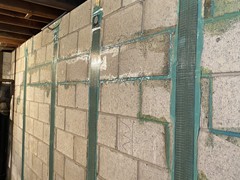 Fortress Stabilization System Carbon-Kevlar straps installed. How the fibers in the straps are arranged is important. Fortress developed a unidirectional method that creates a product twice as strong as conventional products using woven carbon fibers. Every lot produced is tested to meet a guaranteed minimum tensile strength of 234,700 psi.
Fortress Stabilization System Carbon-Kevlar straps installed. How the fibers in the straps are arranged is important. Fortress developed a unidirectional method that creates a product twice as strong as conventional products using woven carbon fibers. Every lot produced is tested to meet a guaranteed minimum tensile strength of 234,700 psi.
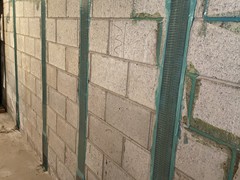 Fortress Stabilization System Carbon-Kevlar straps installed. How the fibers in the straps are arranged is important. Fortress developed a unidirectional method that creates a product twice as strong as conventional products using woven carbon fibers. Every lot produced is tested to meet a guaranteed minimum tensile strength of 234,700 psi.
Fortress Stabilization System Carbon-Kevlar straps installed. How the fibers in the straps are arranged is important. Fortress developed a unidirectional method that creates a product twice as strong as conventional products using woven carbon fibers. Every lot produced is tested to meet a guaranteed minimum tensile strength of 234,700 psi.
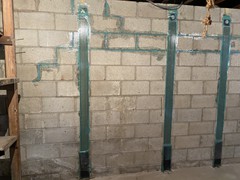 Fortress Stabilization System bottom anchors are 5 times thicker and 125 stiffer than the competition. The dual leg solution with specific contact lengths is engineered to achieve a 200% safety factor. The bottom anchor uses the basement floor to secure the Carbon-Kevlar strap and prevents shear slides.
Fortress Stabilization System bottom anchors are 5 times thicker and 125 stiffer than the competition. The dual leg solution with specific contact lengths is engineered to achieve a 200% safety factor. The bottom anchor uses the basement floor to secure the Carbon-Kevlar strap and prevents shear slides.
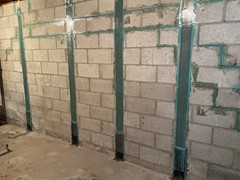 Fortress Stabilization System bottom anchors are 5 times thicker and 125 stiffer than the competition. The dual leg solution with specific contact lengths is engineered to achieve a 200% safety factor. The bottom anchor uses the basement floor to secure the Carbon-Kevlar strap and prevents shear slides.
Fortress Stabilization System bottom anchors are 5 times thicker and 125 stiffer than the competition. The dual leg solution with specific contact lengths is engineered to achieve a 200% safety factor. The bottom anchor uses the basement floor to secure the Carbon-Kevlar strap and prevents shear slides.
 You can see how the pressure being applied from outside the wall has caused cracking in the concrete block joints and is pushing the wall inward.
You can see how the pressure being applied from outside the wall has caused cracking in the concrete block joints and is pushing the wall inward.
 After preparing the surface of the wall, the top anchors are installed to prevent the wall from tipping inward. The bottom anchors are installed at the foot of the wall to protect it from exterior pressure.
After preparing the surface of the wall, the top anchors are installed to prevent the wall from tipping inward. The bottom anchors are installed at the foot of the wall to protect it from exterior pressure.
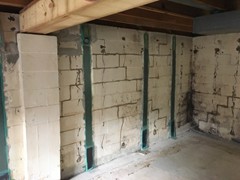 Here you can see the finished Fortress InvisiBeam anchoring system installed.
Here you can see the finished Fortress InvisiBeam anchoring system installed.
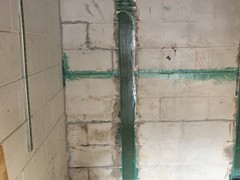 The ICC-certified epoxy glue is thoroughly applied to every section of the system; guaranteeing adhesion and no movement for a lifetime!
The ICC-certified epoxy glue is thoroughly applied to every section of the system; guaranteeing adhesion and no movement for a lifetime!
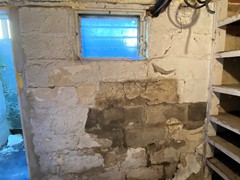 This concrete block basement foundation wall has an inward bow.
This concrete block basement foundation wall has an inward bow.
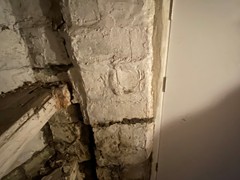 This concrete block basement foundation wall has an inward bow.
This concrete block basement foundation wall has an inward bow.
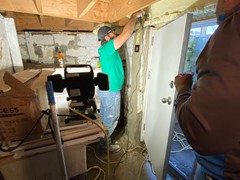 We prepared the wall for installation of the straps. The top anchor is installed directly into the rim joist.
We prepared the wall for installation of the straps. The top anchor is installed directly into the rim joist.
 The completed project including top anchors, carbon straps and bottom anchors, gives this homeowner lifetime protection from tipping, bowing and sheering.
The completed project including top anchors, carbon straps and bottom anchors, gives this homeowner lifetime protection from tipping, bowing and sheering.
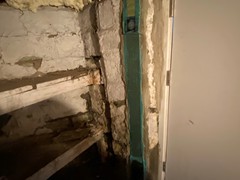 The completed project including top anchors, carbon straps and bottom anchors, gives this homeowner lifetime protection from tipping, bowing and sheering.
The completed project including top anchors, carbon straps and bottom anchors, gives this homeowner lifetime protection from tipping, bowing and sheering.
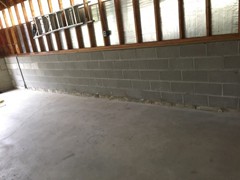 This half concrete block wall did not, independently, have the support it needed and had begun tipping.
This half concrete block wall did not, independently, have the support it needed and had begun tipping.
 We prepared the wall for the Fortress Stabilization InvisiBeam System.
We prepared the wall for the Fortress Stabilization InvisiBeam System.
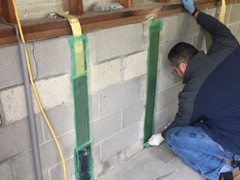 The owner of A Plus Concrete & Foundation Repair, Gary, works on each stabilization project and is a Master Installer. Here he is applying the epoxy glue to a carbon strap.
The owner of A Plus Concrete & Foundation Repair, Gary, works on each stabilization project and is a Master Installer. Here he is applying the epoxy glue to a carbon strap.
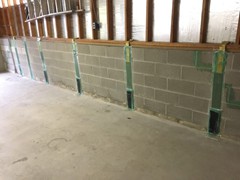 This is the nearly finished system. This customer is guaranteed that this wall will not move for a lifetime.
jquery lightbox menuby VisualLightBox.com v5.7
This is the nearly finished system. This customer is guaranteed that this wall will not move for a lifetime.
jquery lightbox menuby VisualLightBox.com v5.7